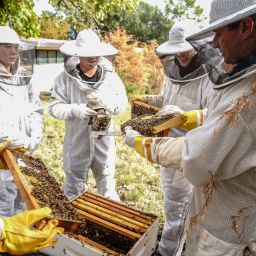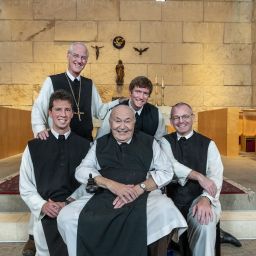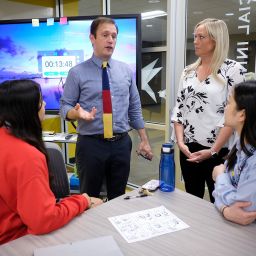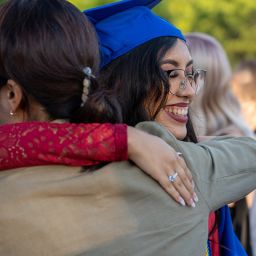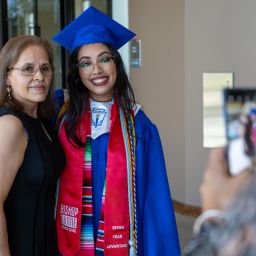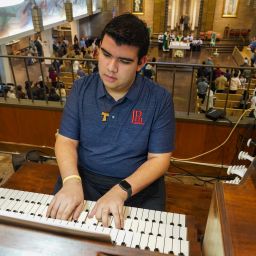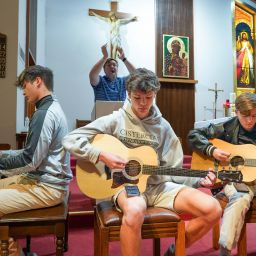By Amy White
The Texas Catholic
COSTA RICA — When missionaries on the Diocesan Youth Mission Trip arrived in Costa Rica on June 5, they began their trip wide-eyed and unsure. Many of the high school students had never left the United States; some had never engaged in hard labor or gone without certain creature comforts. Stepping into an unfamiliar country with simple amenities and a slower pace of life, many of these high schoolers found themselves homesick, uncomfortable, and uncertain at the beginning of their trip.
But, by the time the missionaries returned to Dallas June 12, they were changed: stronger, surer, cheerier. They had embraced the simplicity of their lifestyle in Costa Rica, marveled at the beauty of their natural surroundings, and perceived God’s hand in both.
“It’s like a fresh start almost after this mission,” Cistercian Preparatory School student Ben Brittian said of the trip. “I feel like a different person in so many different ways.”
Hosted annually by the Diocese of Dallas’ Office of Catholic Social Ministries, the Diocesan Youth Mission Trip originated under the leadership of Deacon Charlie Stump, who was named the director of Pastoral Services in 1999.
“The Pastoral Services Office and the campus ministers of the schools wanted to provide a missionary experience—service, work, social action, hands on work with people in Central America,” said Juan Rendon, director of the Diocese of Dallas’ Catholic Social Ministries Office, “so that our students, our kids in the diocese, would learn about the Church, be part of the Church, and see themselves as a Church—as one body, one faith, one baptism, one Lord Jesus Christ.”
At the mission’s genesis, missionaries traveled to Honduras to assist struggling communities there; however, as travel to Honduras became increasingly unsafe due to regional violence, student missionaries began traveling to Nicaragua instead, serving in the area from 2013-17. In 2018, the diocese hosted its inaugural youth mission trip to Costa Rica; and, in 2024, Rendon assumed leadership of the Costa Rica mission trip.
Work of the hands
Overlooking an expansive landscape of green mountains hugged by blue skies and cotton ball clouds, a small church sits on a cliffside. This church is in Guadalupe, a community in Pejibaye, Costa Rica, and is one of the four sites at which missionaries from Dallas served during their stay in Costa Rica June 5-12, 2024.
The group of Dallas missionaries consisted of 47 high school students from Bishop Dunne High School, Cistercian Preparatory School, John Paul II High School, and Ursuline Academy of Dallas, accompanied by 12 chaperones and two nurses from these schools, and three members of the Diocese of Dallas Pastoral Center staff. Missionaries split into four groups to serve at Casa Santa Familia de Nazaret in San Isidro de El General and at three locations in Pejibaye: Guadalupe, Santa Cecilia, and Pejibaye Centro. This year marked the Dallas diocese’s inaugural mission to the Pejibaye communities.
Students serving at Santa Cecilia helped the local community lay sidewalks around the perimeter of their small chapel and begin construction of a fence. At Pejibaye Centro, students constructed a pathway between the church, Parroquia Nuestra Señora de Lourdes, and the common area for the benefit of elderly and wheelchair-bound church-goers. Students in the Guadalupe community—stationed at that cliffside location overlooking a valley of green—helped members of the local church construct a classroom near their chapel. The classroom will be used for catechism classes as well as social gatherings.
Roman Soriano, one of the eight students serving at Guadalupe, recalled the hard work of leveling the earth, inserting columns into the ground, constructing walls, and pouring a concrete floor for the small classroom; he also recalled the sense of accomplishment he experienced as the structure began to take form.

“When we got there, it was kind of just a bare area with a lot of dirt we had to level; and by the time we left, there was a building there. It was so cool,” the Cistercian student said, noting that some work still remains for the locals before the project is completed.
“I’m really coming back home with this increased love of manual labor.”
At Casa Santa Familia de Nazaret, students helped build a rainwater drainage system and sidewalk at the entrance of the site. They also worked to maintain the hundreds of trees on campus, many of which were planted by previous Dallas diocese missionaries.
Like Soriano, several of the students at the Casa Santa Familia de Nazaret learned to love the physical work they did—the shoveling, wheelbarrowing, concrete-mixing, and tree-trimming.
“I’ve never done a mission trip. I’ve actually never gardened. I’ve never been in the wilderness like this,” said Bishop Dunne student Jett Thompson, who helped tend to the trees at Casa Santa Familia de Nazaret. “It’s really rewarding.”
Siena Patterson, a JPII student serving at that site, said that the sweaty, sometimes grueling labor helped her to grow in confidence and self-understanding.
“I was definitely really scared to do the manual labor, because I’m not always the strongest physically,” she said, “but the trip has really shown me that I can do really difficult things.”
Taylor Salava, another missionary at Casa Santa Familia de Nazaret, agreed.
“With all the sweat and all the hard work, you rely on each other for support,” the JPII student said. “I realized that I’m more capable than I had realized, and I can do it. It was so nice to come here and have that drive, and I can definitely bring that home with me.”
Through their volunteer efforts, the Dallas missionaries also served as a galvanizing force for local Catholic youth, said Giovanni Larios Hernandez, a worker assisting at the Santa Cecilia worksite.
“I am very grateful that the missionaries came from another country to help here,” he said, “and I wish that local groups will go and help as well in other countries where help is needed.”
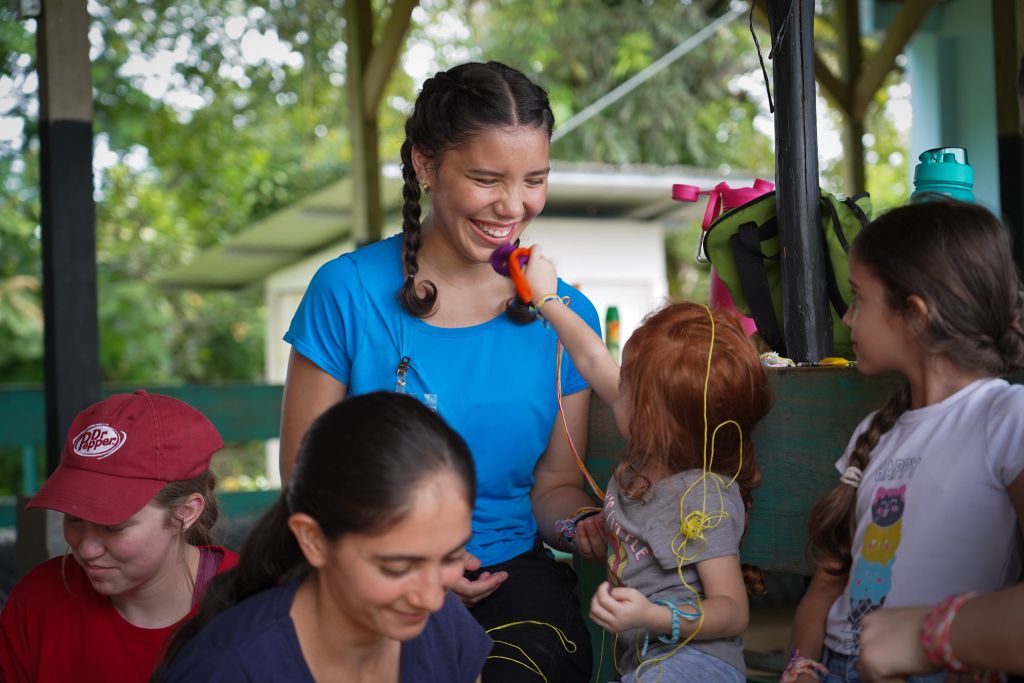
Work of the heart
This physical service that the students undertook during their mission trip was paired with—and undergirded by—a rich foundation of prayer. Missionaries followed a program of reflection, created by the Dallas diocese’s Director of Youth, Young Adult, and Campus Ministries Josh Salinas, which focused on the incorporation of the Beatitudes into daily life and gave context to the service the missionaries were undertaking.
“The work needs to have a context and our time together in prayer, reflection, and Mass provides that context,” chaperone Father Augustine Hoelke, O. Cist., said. He noted that the mission trip offered an opportunity for students to engage in “the work of the hands but also the work of the heart.”
As part of this program of prayer, missionaries attended daily Masses, sometimes alongside members of the local communities.
Father John Bayer, O. Cist., a chaperone on the trip, celebrated Mass with the local Catholics at all three of the Pejibaye sites. At these Masses, student missionaries had the opportunity to retire their shovels, step into the chapel at their worksite, and worship alongside the local workers with which they had labored—many of whom have limited access to the Mass.
Cistercian student Brock Harrod, who attended Masses at Parroquia Nuestra Señora de Lourdes in Pejibaye Centro alongside the local community, said that the faith he witnessed from the Costa Ricans inspired him.
“It’s really humbling to see how they praise God,” he said, noting also the care with which the faithful upkept their chapels. “It moved me, because it made me realize how much they cherish their faith and their time with God.”
At Casa Santa Familia de Nazaret, students embraced the “work of the heart” with additional dedicated times of prayer and reflection.
Sitting cross-legged on the floor outside the dorms, or inside the on-campus chapel, students gathered in the evenings for a small Bible study initiated by JPII chaperone Mickey Saloma. Under the leadership of student volunteers, the group reflected on scripture passages, shared their insights, and lifted their fellow missionaries in prayer.
At the request of several students, this site also hosted eucharistic adoration. In a small, tarped chapel on campus, Father Hoelke led students in an evening of adoration on the last full day of the mission, wrapping the week in prayer.
“It’s beautiful just to see that desire coming to the surface,” Father Hoelke said. “It’s a beautiful opportunity for us to lift up the whole trip in prayer one last time and to really make it a spiritual offering after our physical offering has come to its conclusion.”
Missionaries also encountered God in the wonder of their natural surroundings. In the mornings, birdsong trilled; at night, stars twinkled. Students stepped gingerly over trails of ants, endowed with a new appreciation for and awareness of even the smallest of God’s creatures.
“I’ve been able to see how amazing God is through creation and getting to see all the different animals,” Ursuline student Elsie Leon said.
Bishop Dunne student Rebekah Martinez expressed a similar sentiment.
“It sounds corny, but everything that He made is so beautiful,” she shared. “Even the little ants and the big trees—it’s just so beautiful. He made it so big, and our problems are so small.”

‘Good old life’
In Costa Rica, missionaries encountered barebones lodging and a slower pace of life than the one they know in the U.S.; but many grew to love the simplicity of their days. Although they worked hard—rising early in the morning and slogging into the late afternoon—their labor was interspersed with genuine leisure and moments of deep connection.
Marc Maalouf, a Cistercian student serving the Santa Cecilia community, shared that he experienced valuable connections with members of the local community, which deeply impacted him during his trip to Costa Rica.
“At dinner, I got to sit with Fabricio and Sebastian, two boys from a local community,” he recalled. “We talked about our favorite superheroes, our favorite soccer players. It was just awesome to see how excited they were to meet us and interact with us… Coming here and meeting new people has been very impactful for me. It has shown me how my faith acts as a gateway and a bridge to connect me to people who I’ve never met before in my life.”
The local communities opened their arms to the missionaries, inviting them to play pick-up soccer, explore their communities, or swish traditional skirts during Baile Folklórico dancing.
“It’s been incredibly eye-opening to see the community here, just how happy everyone is,” Ursuline student Ryan Fogel said. “They’ve been so nice and so welcoming; everyone has been.”
“They really enjoyed being there with the people and how much fun it is to play with the kids and how much they enjoyed playing tag and soccer and Spikeball,” Father Bayer reflected. “It was clear how much the community enjoyed our presence and how they were seeking a relationship… The gift that they wanted to give was their faith and hospitality, and I think our students received that.”
Missionaries also connected with one another during their trip. With their cellphones left behind at home, students who had previously lived separate lives in Texas became fast friends over plates of beans, rice, and plantain.
“I didn’t expect to get to know so many people from other schools,” JPII student Adrienne Frye said. “It’s been great, because normally you’re just on your phone at lunch and don’t necessarily talk to people as much, but we’re really getting to know each other more.”
“I think the students are probably most impacted by experiencing a simple life lived for relationship and love, family and friends, and discovering how fulfilling that is,” Father Bayer said. “It was really sweet to see them happy doing such simple relational things and not needing fancy clothes, not needing technology—Just good old life.”
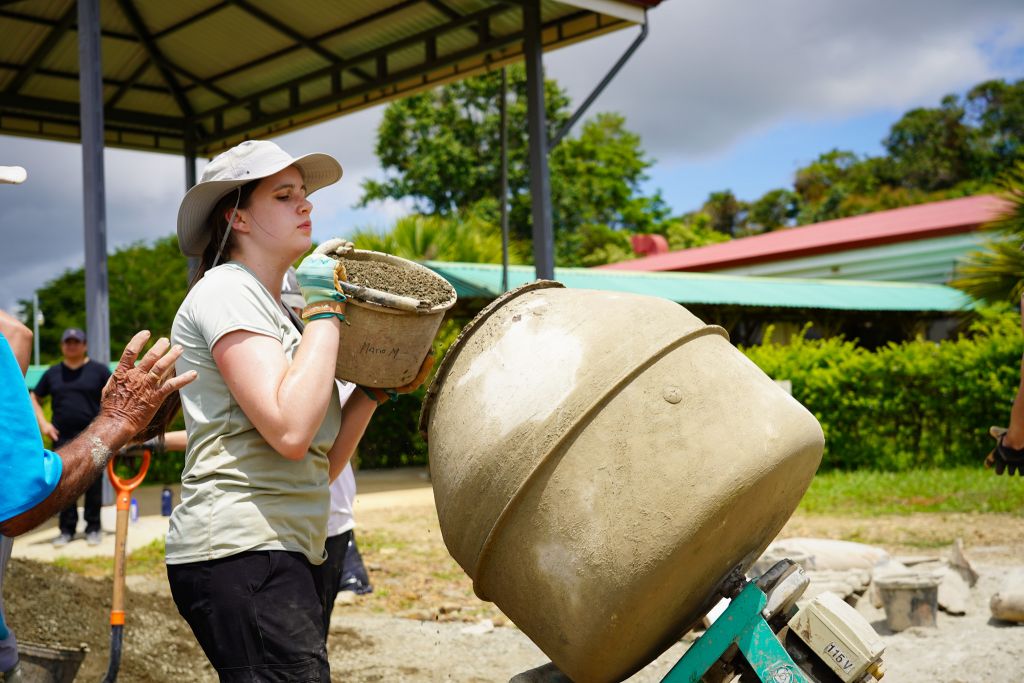
Missionaries in Dallas
When the plane touched down in Dallas on June 12, the trip was over—but in some sense, the mission had just begun. Students traveled home with the lessons they learned abroad and with earnest resolutions for the future.
Many missionaries resolved to embrace the slower, Costa Rican lifestyle: to live more simply, waste less, worry less—to celebrate the Sabbath and balance labor and leisure during their weeks. Some promised to spend more time in nature, more time with God and community, and less time on their phones. They took home a new spirit of joy in work, pleasure in play, and trust in God.
Students came home different, and they came home resolved.
“This mission trip made me really appreciate what I have and appreciate the simplicity of life,” Salava reflected. “I really want to go back home and just do everything with a purpose in my life.”
Find more images from the 2024 Youth Mission Trip to Costa Rica in the photo gallery.

